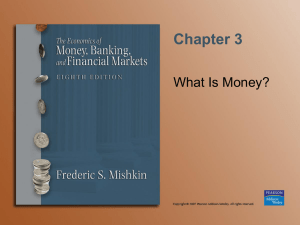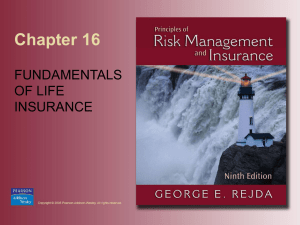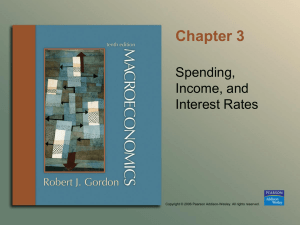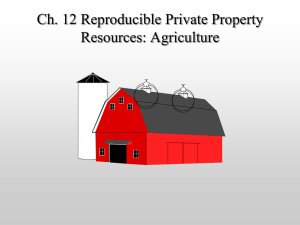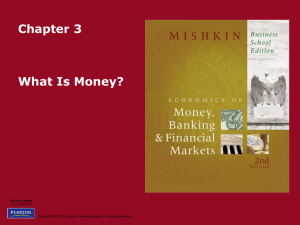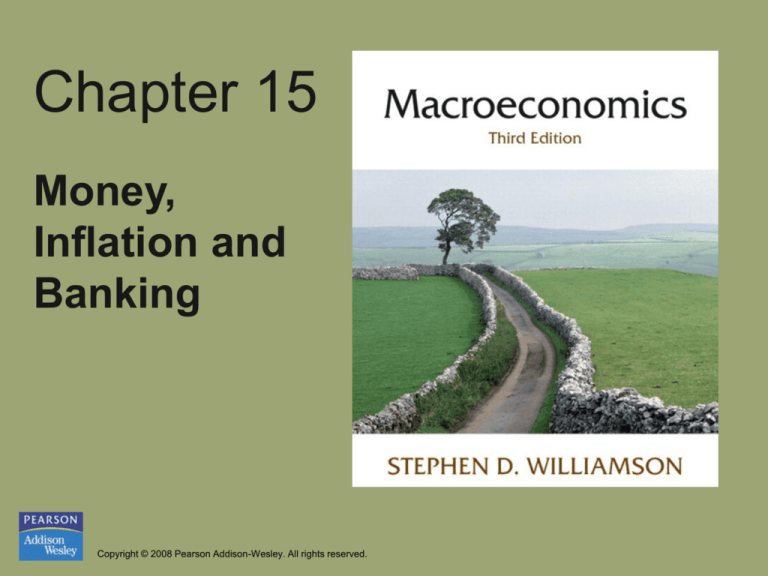
Chapter 15
Money,
Inflation and
Banking
Copyright © 2008 Pearson Addison-Wesley. All rights reserved.
Chapter 15 Topics
• Alternative forms of money.
• Money and the absence of double coincidence of
wants.
• The causes and effects of long-run inflation.
• Financial intermediation and banking.
Copyright © 2008 Pearson Addison-Wesley. All rights reserved.
15-2
Alternative Forms of Money
•
•
•
•
•
Commodity money
Circulating private bank notes
Commodity-backed paper currency
Fiat money
Transactions deposits at banks
Copyright © 2008 Pearson Addison-Wesley. All rights reserved.
15-3
The Double-Coincidence
Problem and the Role of Money
• Barter exchange is difficult in highly-developed,
specialized economies.
• Economic exchange requires search costs, and these
costs are high when economic agents are specialized in
consumption and production, and can only trade a good
or service for another good or service.
• Search costs are reduced dramatically if everyone
accepts money in exchange for goods and services.
Copyright © 2008 Pearson Addison-Wesley. All rights reserved.
15-4
Figure 15.1 An Absence-of-DoubleCoincidence Economy
Copyright © 2008 Pearson Addison-Wesley. All rights reserved.
15-5
Figure 15.2 Good 1 as a Commodity
Money in the Absence-of-DoubleCoincidence Economy
Copyright © 2008 Pearson Addison-Wesley. All rights reserved.
15-6
Figure 15.3 Fiat Money in the Absenceof-Double-Coincidence Economy
Copyright © 2008 Pearson Addison-Wesley. All rights reserved.
15-7
The Effects of Long-Run
Inflation
• Use the monetary intertemporal model from
Chapter 10.
• Show that money is not superneutral – higher
money growth causes higher inflation, which
affects real economic variables.
• An increase in the money growth rate increases
the inflation rate and the nominal interest rate,
and reduces employment and output.
Copyright © 2008 Pearson Addison-Wesley. All rights reserved.
15-8
Figure 15.4 Scatterplot of the Inflation
Rate vs. the Growth Rate in M0 for the
United States, 1960–2006
Copyright © 2008 Pearson Addison-Wesley. All rights reserved.
15-9
Equation 15.1
Assume that the central bank causes the money
supply to grow at a constant rate.
Copyright © 2008 Pearson Addison-Wesley. All rights reserved.
15-10
Equation 15.2
In equilibrium, money supply equals money
demand.
Copyright © 2008 Pearson Addison-Wesley. All rights reserved.
15-11
Equation 15.3
Money supply also equals money demand in the
future period.
Copyright © 2008 Pearson Addison-Wesley. All rights reserved.
15-12
Equation 15.4
Combine the previous two equations.
Copyright © 2008 Pearson Addison-Wesley. All rights reserved.
15-13
Equation 15.5
The consumer’s intertemporal marginal condition.
Copyright © 2008 Pearson Addison-Wesley. All rights reserved.
15-14
Equation 15.6
Marginal condition reflecting the consumer’s
tradeoff between current leisure and future
consumption:
Copyright © 2008 Pearson Addison-Wesley. All rights reserved.
15-15
Equation 15.7
Marginal condition reflecting the consumer’s
tradeoff between current leisure and current
consumption:
Copyright © 2008 Pearson Addison-Wesley. All rights reserved.
15-16
Figure 15.5 The Long-Run Effects of
an Increase in the Money Growth Rate
Copyright © 2008 Pearson Addison-Wesley. All rights reserved.
15-17
The Friedman Rule
• Inflation causes an inefficiency, in that it distorts
intertemporal decisions.
• The Friedman rule is a prescription for monetary
growth that eliminates the inefficiency caused by
inflation.
• The Friedman rule specifies that the money stock grow
at a rate that makes the nominal interest rate zero.
• In practice, no central bank appears to have adopted a
Friedman rule to guide monetary policy.
Copyright © 2008 Pearson Addison-Wesley. All rights reserved.
15-18
Equation 15.9
Pareto optimality requires that
Copyright © 2008 Pearson Addison-Wesley. All rights reserved.
15-19
Equation 15.10
In a competitive equilibrium,
Copyright © 2008 Pearson Addison-Wesley. All rights reserved.
15-20
Equation 15.11
Also, in a competitive equilibrium,
Copyright © 2008 Pearson Addison-Wesley. All rights reserved.
15-21
Properties of Assets
•
•
•
•
Rate of return
Risk
Maturity
Liquidity
Copyright © 2008 Pearson Addison-Wesley. All rights reserved.
15-22
Defining Characteristics of
Financial Intermediaries
1. Borrow from one group of economic agents
and lend to another.
2. Well-diversified with respect to both assets and
liabilities.
3. Transform assets.
4. Process information.
Copyright © 2008 Pearson Addison-Wesley. All rights reserved.
15-23
The Diamond-Dybvig Banking
Model
• Three periods, 0, 1, and 2.
• Two types of consumers: early (consume in
period 1) and late (consume in period 2)
• Efficient economic arrangement is for
consumers to set up a bank in order to share risk.
• Given the bank’s deposit contract, the bank is
open to a run, which is a bad equilibrium.
Copyright © 2008 Pearson Addison-Wesley. All rights reserved.
15-24
Figure 15.6 The Utility Function For a
Consumer in the Diamond–Dybvig Model
Copyright © 2008 Pearson Addison-Wesley. All rights reserved.
15-25
Figure 15.7 The Preferences of a
Diamond–Dybvig Consumer
Copyright © 2008 Pearson Addison-Wesley. All rights reserved.
15-26
Equation 15.12
• The marginal rate of substitution of early
consumption for late consumption is
Copyright © 2008 Pearson Addison-Wesley. All rights reserved.
15-27
Equation 15.13
• First constraint that a deposit contract must
satisfy is
Copyright © 2008 Pearson Addison-Wesley. All rights reserved.
15-28
Equation 15.14
Second constraint that a deposit contract must
satisfy is
Copyright © 2008 Pearson Addison-Wesley. All rights reserved.
15-29
Equation 15.15
Combine the two constraints to get one:
Copyright © 2008 Pearson Addison-Wesley. All rights reserved.
15-30
Equation 15.16
Re-write the constraint:
Copyright © 2008 Pearson Addison-Wesley. All rights reserved.
15-31
Figure 15.8 The Equilibrium Deposit
Contract Offered by the Diamond–Dybvig
Bank
Copyright © 2008 Pearson Addison-Wesley. All rights reserved.
15-32

